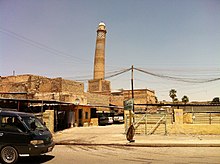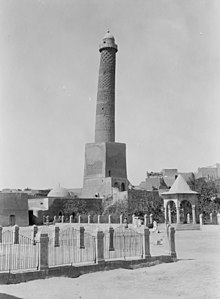
The minaret of the Al-Nouri mosque in 2013
Mosul rising: UNESCO launches an international architectural ...
en.unesco.org › news › mosul-rising-...
Mosul rising: UNESCO launches an international architectural competition to rebuild Al-Nouri mosque. 17/11/2020. × ...
The architectural competition for the reconstruction ... - UNESCO
en.unesco.org › news › architectural-...
このページを訳す
2020/11/16 — The architectural competition for the reconstruction and rehabilitation of the Al Nouri complex in Mosul. ... UNESCO, in close coordination with the Iraqi Ministry of Culture and the Iraqi Sunni Endowment and the support of the ...
《路透》報導,「伊斯蘭國」21日晚間炸毀了摩蘇爾(Mosul)知名地標努爾大清真寺(Great Mosque of al-Nuri)和其附帶的傾斜喚拜塔「駝子」(al-Hadba)。現場滿目瘡痍的空拍照曝光,清真寺和喚拜塔面目全非。
IS大勢已去?伊斯蘭國炸毀近千年清真寺 領袖巴格達迪3年前在此「登基」-風傳媒
伊拉克政府22日宣布,恐怖組織「伊斯蘭國」(IS)炸毀摩蘇爾當地的著名古蹟「努爾大清真寺」和其知名的傾斜喚拜塔,矗立近900年的古蹟瞬間成為斷…
STORM.MG|作者:風傳媒
The Great Mosque of al-Nuri (جامع النوري) was a mosque in Mosul, Iraq. It was famous for its leaning minaret, which gave the city its nickname "the hunchback" (الحدباء al-Ḥadbāˈ). Tradition holds that the mosque was first built in the late 12th century, although it underwent many renovations over the years. Most of it was destroyed on 21 June 2017, during the Battle of Mosul. ISIS claims that the USA destroyed it, while Iraqi troops claim ISIS responsible.
Construction[edit]
Tradition holds that [Nurettin Zengin] (Nur ad-Din Zangi) the Turkish Atabeg built the mosque in 1172–1173 during the Abbasid Caliphate, shortly before his death.[1] According to the chronicle of Ibn al-Athir, after Nur ad-Din took control of Mosul he ordered his nephew Fakhr al-Din to build the mosque:
In 1511, this mosque was extensively renovated by the Safavid Empire.[citation needed]
Minaret[edit]
The mosque was well known for its leaning minaret, known as al-Hadba’ ("the hunchback"). Grattan Geary, a 19th-century traveler, described the minaret's appearance:
When the cylindrical minaret was built it stood 45 metres (148 ft) high, with seven bands of decorative brickwork in complex geometric patterns ascending in levels towards the top. By the time the traveler Ibn Battuta visited in the 14th century it was already listing and had acquired its nickname.[4] The design of the minaret follows a form originally developed in neighboring Iran and Central Asia and shares similarities with other minarets in northern Iraq, such as those in Mardin, Sinjar and Arbil.[5]
According to local tradition (which resolutely ignores chronology), the minaret gained its tilt after the Prophet Muhammad passed overhead while ascending to heaven. The minaret bowed itself in reverence but could only regain its balance after its top joint had been kinked in the opposite direction.[6] According to local Christian tradition, however, the mosque's tilt was due to its bowing towards the tomb of the Virgin Mary, reputedly located near Arbil.[3]
Modern history[edit]
Both the mosque and its madrasa were dismantled and reassembled in 1942 in a restoration programme undertaken by the Iraqi government.[4] The minaret remained unrestored, although attempts were made in 1981 by an Italian firm to stabilise it. The bombing of Mosul during the Iran–Iraq War in the 1980s broke underground pipes and caused leaks under the minaret that further undermined it. The lean later worsened by another 40 centimetres (16 in).[7]
The cause of the lean was disputed – some have blamed the prevailing wind – but local officials have attributed it to the effects of thermal expansion caused by the heat of the sun, causing bricks on the sun-facing side to expand and progressively tilt the minaret.[7] In recent years cracks proliferated along the base of the minaret, which leant nearly 3 metres (9.8 ft) off the vertical. It was listed by the World Monuments Fund as a site of concern due to the ongoing risk of collapse.[4]
The structure was targeted by Islamic State of Iraq and the Levant militants who occupied Mosul on 10 June 2014, and previously destroyed the Tomb of Jonah. However, residents of Mosul, incensed with the destruction of their cultural sites, protected the mosque by forming a human chain and forming a resistance against ISIL.[8] Rather than destroying the site, Abu Bakr al-Baghdadi appeared during a Friday prayer in this mosque on 4 July 2014 to declare the formation of a new caliphate.[9]
The mosque, including its minaret, was destroyed in June 2017 – according to the Iraqi PM, by ISIS fighters. [10]
Destruction[edit]
By June 2017, the Battle of Mosul had progressed to the stage that ISIL-controlled territory in Mosul was limited to the Old City area, which included the mosque. On 21 June 2017, Iraqi government forces reported that the mosque had been blown up by ISIS forces and the blast was indicative of bombs being deliberately placed to bring it down [11]. ISIL's propaganda ministry Amaq claimed an airstrike by the United States is responsible for the destruction, but this claim does not appear to be substantiated by any information.[12][13][1] Iraqi forces were within 50 meters of the mosque before the explosion which appears to have been an attempt to kill members of the approaching army by members of ISIL.[1] Aerial photos of the destruction were released by the Iraqi military a few hours later.[12]
Iraqi Prime Minister Haider al-Abadi stated that the destruction of the mosque was ISIS' "declaration of defeat".[12] BBC News journalist Paul Adams wrote of the mosque's destruction as ISIS' "final act of angry defiance before finally losing their grip on Mosul".[12]

沒有留言:
張貼留言
注意:只有此網誌的成員可以留言。